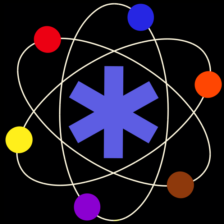99 percent are excellent! Would we think the same if 99 percent of all flights worldwide arrived at their destination without a crash? Well, how do airlines worldwide achieve letting us enjoy the view of the scenery from above in such a relaxed manner? They provide us with a maximum of safety by
consequently employing crew resource management.
1. This is CRM - and What You Achieve Using It
Below, you will find ample information on important aspects of crew resource management. Every month, I address particular themes within CRM on my Blog in order to elucidate them together with you.
1.1. This Is CRM
Crew Resource Management offers approaches to efficient teamwork, and lossless communication, decision making, and leadership in order to prevent failure, first and foremost in high risk work environments.
1.2. What You Can Achieve Using CRM
As a team leader, as well as a team member you will know how to contribute to completing complex tasks and solving problems. Hence, you will ensure the success of your team.
You will know how to reduce the risk for failure sufficiently. Thus, you contribute considerably to:
- your patients´ safety
- your customers´ satisfaction
- saving money, as recourse claims become less likely
By optimising teamwork, you will enhance your teams´ performance and ensure:
- your colleagues´ satisfaction, as work runs smoothly
- great team spirit, because everyone is heard and appreciated
- less absence due to illness and fewer notices of termination
2. How Teams Collaborate to Enhance Safety
Below, you will find a selection of vital concepts from the wide scope of CRM.
2.1. Ressourcen im Team
Crew Resource Management, CRM, lends itself to the optimisation of teamwork. The resources to accomplish this are all the team members and their leader. All of them provide their knowledge, as well as their hard and soft skills. The entire team is particularly focused on collaborating smoothly.
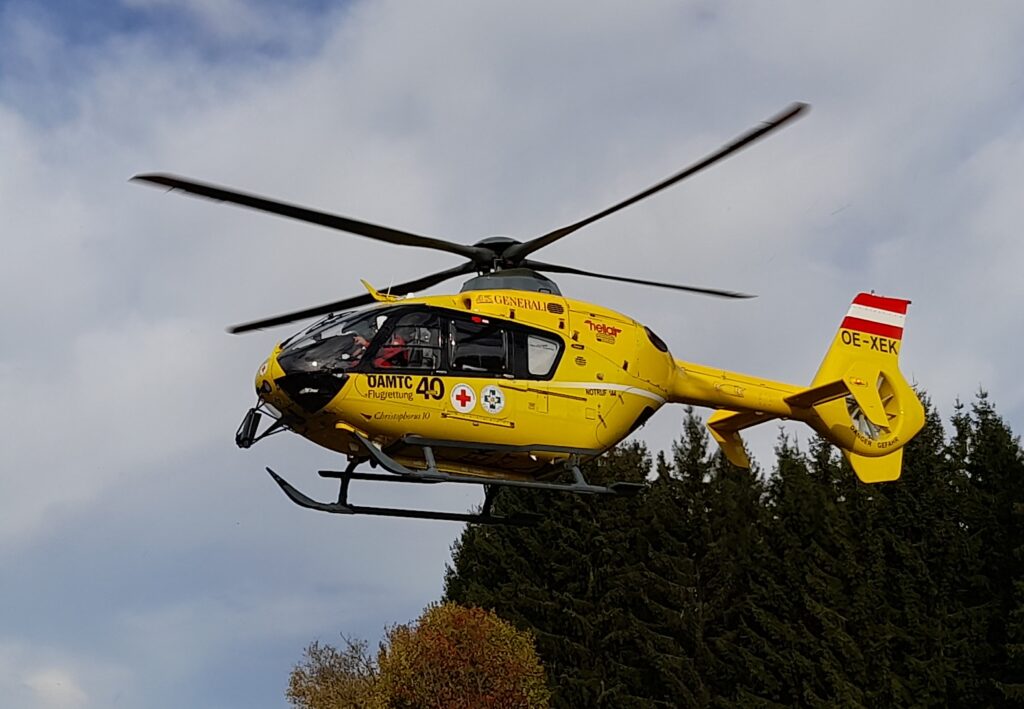
1.2. Material Resources, Checklists and Standard Operating Procedures are Available to the Team
2.2.1. Material Resources
In addition, there are technical and material resources which the team deploys in a skilful manner. These may include the dashboard on a flight deck of an airliner, or the equipment used to extricate a trapped patient from a damaged car. Humans and technology have to interact perfectly which requires communication, coordination, and sufficient practice.
2.2.2. Checklists
Checklists for a certain course of action prevent that individual, but relevant items are forgotten. You may be well aware of the fact that pilots carefully work their way through such lists before takeoff.
2.2.3. Standard Operation Procedures, SOPs
Standard operating procedures, SOPs, are standardised guidelines for numerous situations and incidents that provide the user with tried and tested instructions. Thus, they reduce the risk of errors.
SOPs are established at many workplaces and not only employed by paramedics when treating typical illnesses which they encounter during their calls.
2.3. Communication Without Loss of Information
Efficient and complete communication within the team plays a crucial role concerning safety. It guarantees that everyone receives vital information.
You may spontaneously recall situations, in which the loss of a relevant piece of information has led to momentous consequences.
In the emergency medical service, it may be a low blood sugar level in an unconscious patient, which a team member states aloud, but the information goes unnoticed by his or her teammates. They may be occupied with other tasks, and the one who had taken the blood glucose may not be aware of that.
In this case, the cause of the unconsciousness could have been found quickly and treated easily.
Using CRM, we prevent such a loss of information employing easy to learn communication techniques. Reading back pieces of information consequently is a good example. If someone does not repeat a message, this will be required by the sender.
2.4. Workload Management
Good teamwork and communication also lend a helping hand to efficient workload management. The teamleader has an overview of all the tasks and their current state of completion.
The team members communicate whether they currently are available or occupied. In addition, every member tells the teamleader honestly if a task is too difficult for him or her. If this is the case, it can be assigned to someone more experienced.
Using CRM that way, we avoid making mistakes which may occur, because someone does not dare to admit that he or she is overstrained.
2.5. Decision Making
Taking all factual information, the team members´ thoughts, and if necessary their concerns into account, a teamleader can make the best decision at a specific point in time. Here, we have another example of how teams resort to precious resources.
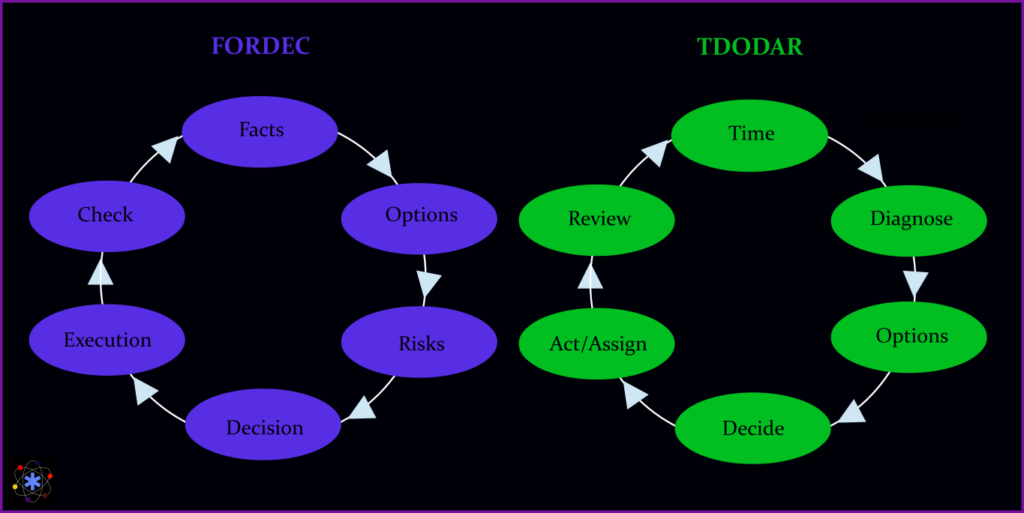
3. Fatal Airplane Crashes Laid the Foundation - an Overview of CRM Development
Briefly, I will introduce you to important milestones of CRM.
3.1. The Role of Air Disasters in the 1970ties
Since passenger flights became more widespread, fatal air disasters have occurred time and again. The worst air accident so far happened on the Island of Tenerife in March 1977.
583 people lost their lives as two jumbo jets collided on the runway. The captain of a KLM aircraft had begun taking off without the necessary takeoff clearance from the control tower. At the same time, a Pan Am airliner was still taxiing down the runway.
Not only the takeoff commenced without takeoff clearance, but also a chain of events and circumstances contributed to the disaster.
A prominent merrit of aviation is the meticulous investigation of such error chains, as well as all other circumstances which have contributed to an air disaster. The insights gained are used to introduce novel safety standards, for instance.
3.2. In the Beginning, CRM Represented Cockpit Resource Management
3.2.1. Cockpit Resource Management
In the early 1970ties, the development of CRM started, aiming at the prevention of air disasters.
The intention was to flatten the hierachy and to consider all cockpit crew members as valuable resources. This was revolutionary in a world in which captains were regarded as sole all-rounders.
However, in doing so one was able to focus more on whole teams´ collaboration. The team members help to prevent fatal errors, for example, by providing vital information. This enhances the overall safety like a safety net.
The Tenerife air disaster influenced this development greatly. The flight engineer of the KLM airliner had overheard that the Pan Am jet might still be on the runway.
He pointed his concern out to the captain, but was rejected abruptly. Consequently, he did not insist by asking once again. This happend several seconds before the speed at which a takeoff cannot be abandoned any more was reached.
When CRM is applied today, a so-called speak up is always possible for any team member. The team will then explore the objection in order to prevent a potentially horrendous error (see also 5.1.3.).
3.2.2. Involving the Cabin Crew
As the development moved on, the cabin crew was included into the teamwork. Thus, Crew Resource Management was created.
The air disaster, which happend near the village of Kegworth in Great Britain in 1989, played a decisive role. When one of the two engines failed, leading to severe vibrations of the whole aircraft, as well as to the emission of sparks and flames, the pilots turned off the wrong engine.
Some passengers, but also three cabin crew members could see the flames and sparks, whereas the pilots in the cockpit are not able to see the engines.
However, nobody dared to disturb the pilots in this tense situation. In addition, first and foremost the passengers thought that the pros most likely knew what they were doing.
Only 900 metres away from the runway, the aircraft hit the ground and broke into three parts. 47 of the 226 people on board died.
When the air disaster was examined, once more several factors which had led to the pilots´ decision were identified. Again, this highlights the relevance of the meticulous investigations carried out in the aviation industry, from which everyone of us can learn.
3.3. Specific Training, Science, and Worldwide Introduction of CRM in the Aviation Industry
Of course, you are aware that pilots practise in flight simulators regularly. There, they get the opportunity to refine certain manoeuvres and the handling of emergencies.
This is only a small part of actively lived CRM, which was made mandatory by airlines worldwide in the early 1990ties.
Extensive scientific work accompanies the divulgence of CRM. A comprehensive book on all aspects of CRM, which includes many a relevant reference, has been written by Kanki et al. (Kanki, B. G., Anca J., Chidester T.R., editors (2019): Crew Resource Management (third edition). Academic Press, London, Oxford, Boston, New York, San Diego)).
3.4. The Successful Concept Makes Its Way to Other High Risk Work Environments
Not only in the aviation industry, but also in other lines of business errors can have fatal consequences. Due to its effectiveness, CRM was adopted there, as well.
Maintenance Resource Management, MRM, is very similar to CRM. It helps to maximise safety in the maintenance of, for example, aircraft.
4. Where You Can Take Advantage of CRM - Scope of Application
Today, CRM is not only employed in the aviation industry, but also in other high risk work environments, such as:
- maritime shipping
- the offshore oil industry
- the railway industry
- the nuclear industry
- healthcare
In healthcare, simulation trainings become more and more widespread, which is much to be welcomed.
According to the professional disciplines, cardiopulmonary resuscitation, scenarios in the emergency room, or complications at birth can be rehearsed.
High-tech simulators are deployed instead of real patients. Hence, no patient can be injured, and scenarios can be practised until the team masters them.
In clinical practice, the use of CRM has increased remarkably. For example, in the emergency room or in the modern emergency medical service.
5. What Are the Magic Ingredients to Successful Crew Resource Management?
As we said above, main components of CRM include teamwork, and communication, adequate leadership, and decision making.
Here, you will find a selection of further important CRM concepts. Using these, you will perfect the results of your teamwork.
5.1. Further Important CRM Concepts
5.1.1. Situational Awareness
When we tend our patients in the emergency medical service, we do so in a general situation, which includes the emergency scene, the patient, as well as further information, such as preexisting illnesses. The emergency scene may be a flat, in which several persons are present, or a public square with onlookers, or a country road at a rainy night.
We have to process the information we get from this general situation and, using our knowlegde and experience as a team, work out a shared mental frame of what is happening.
Then, we can use this mental frame to assess the situation continuously, make decisions, or to anticipate potential threads.
5.1.2. Speak Up
Have we always dared to point out our observation to someone who was about to make a mistake? If not, why?
To speak up for so./sth. has made its way into the vocabulary German speaking CRM practicioners use.
In CRM it means that anyone, regardless of his or her role within the team and his or her hierarchy level, should state clearly if he or she is concerned, or has identified a mistake.
Anyone who is not immediately heard, should insist until they get their message across.
If we now recall the flight engineer mentioned earlier, we understand the potential momentousness of a speak up.
5.2. Dealing With Human Factors
Do you sometimes feel really tired, but a long workday lies ahead of you? Or have you even been fatigued for some time already?
There is an important deadline you have to meet today, but relevant resources are not available to you, especially enough time? And now you can feel the pressure?
In CRM we concern ourselves with the influence which the so-called human factors can have on a teams´ performance. These factors weigh on all of us.
They can trigger mistakes. As we cannot eradicate these triggers completely, we need efficient methods to deal with them, for example, with stress and fatigue.
Depending on the publication or the line of business, different factors in varying numbers are listed. In crew resource management, the so-called "dirty dozen" has become famous:
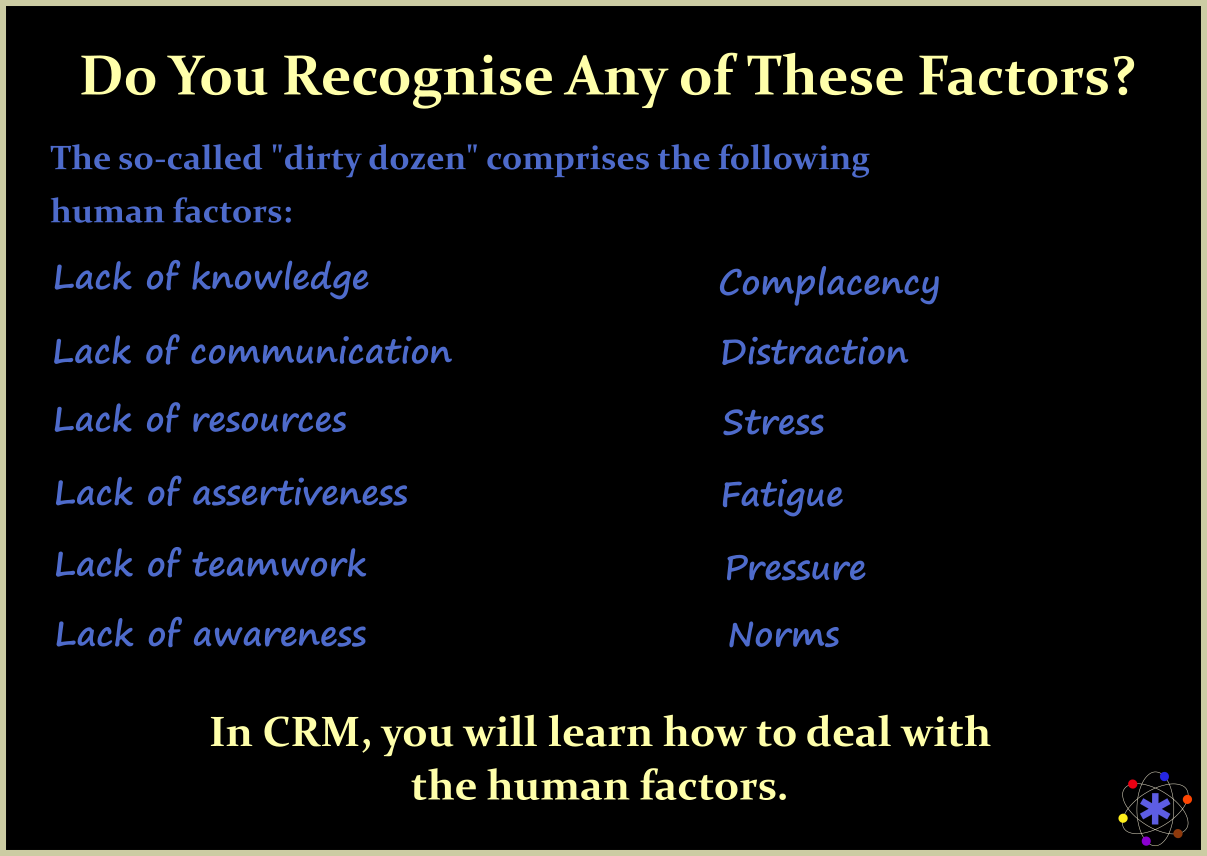
6. Error Management - Why Mistakes and Their Correction Do Matter
Do you also strive to perform the best you can at all times when you are dealing with your patients or customers? And, as we all do, you sometimes make a mistake, you would prefer not to repeat?
It is well known that anyone can make a mistake at any time, regardless of his or her role. These mistakes are inevitable. No one makes them intentionally. Rather, we make mistakes, because we do not know better at that point in time.
Not the mistake in itsself is decisive, but the reason why it happend. We must shed our light on the root cause.
It is not the question of guilt which is important, or even naming and punishing a "scapegoat", but:
What can we learn from our mistake, and how do we prevent it in the future?
Thus, we need an error management, which allows for constructive correction of our mistakes. As professionals can feel safe in such a culture, they will be more likely to report failure and deal with it. It is less likely that mistakes will be covered up due to the fear of negative consequences.
7. My CRM Seminars and CRM Books
7.1. This Is How You Profit From My Comprehensive CRM Seminars
My aim is to introduce you to CRM comprehensively, in the same way it is teached and lived in the aviation industry, from which it originated. Therefore, I will include all the concepts and components I mentioned above.
It is my goal not only to give you an insight into the entire field during the seminar, but also that you can use what you have learned at your job in the most beneficial manner.
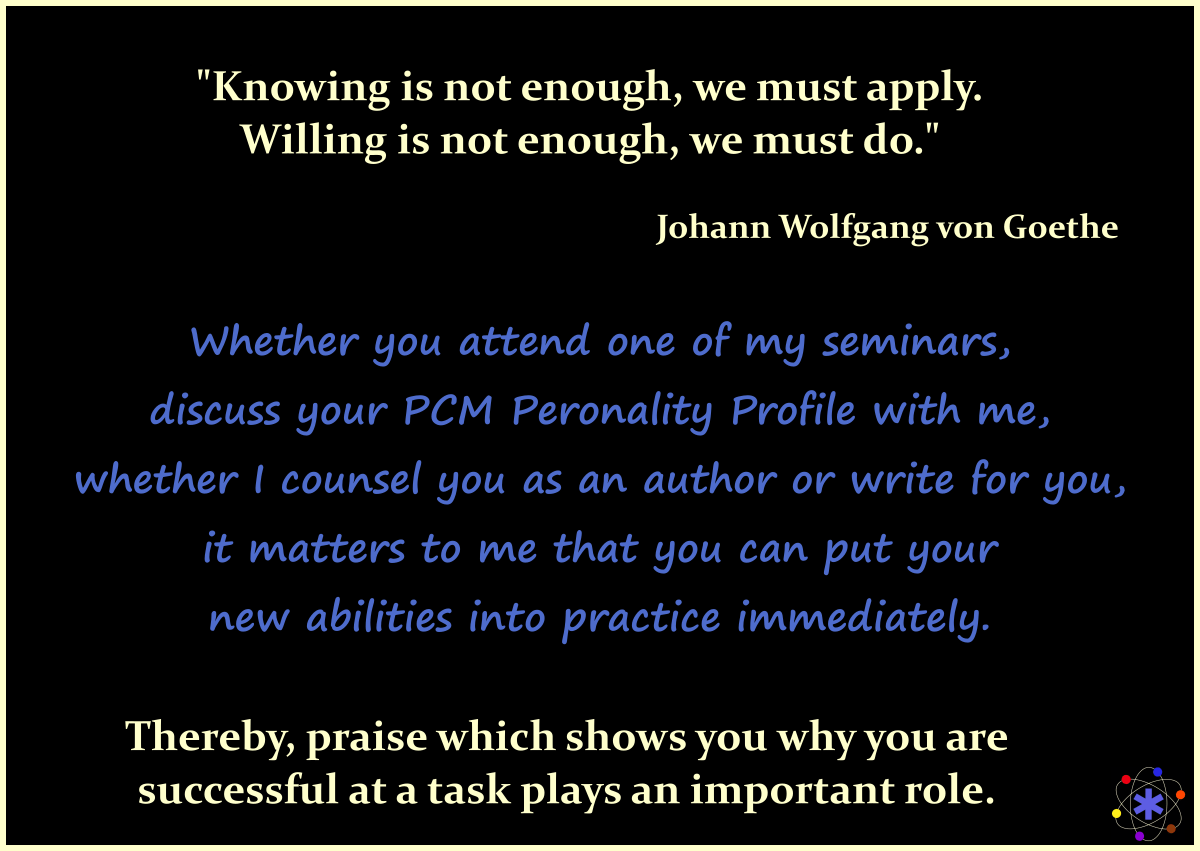
Learn more about my CRM Seminars for beginners and advanced learners.
If you are ready, book directly.
7.2. CRM Books to Read, Learn, and Look up
In February 2024, I will publish the first volume of my "Special CRM Collection" . There, you will read older articles from my blog, which I have revised carefully and organised didactically in handy separate chapters. The first volumes of my comprehensive CRM Textbook will most likely be published in December 2024.
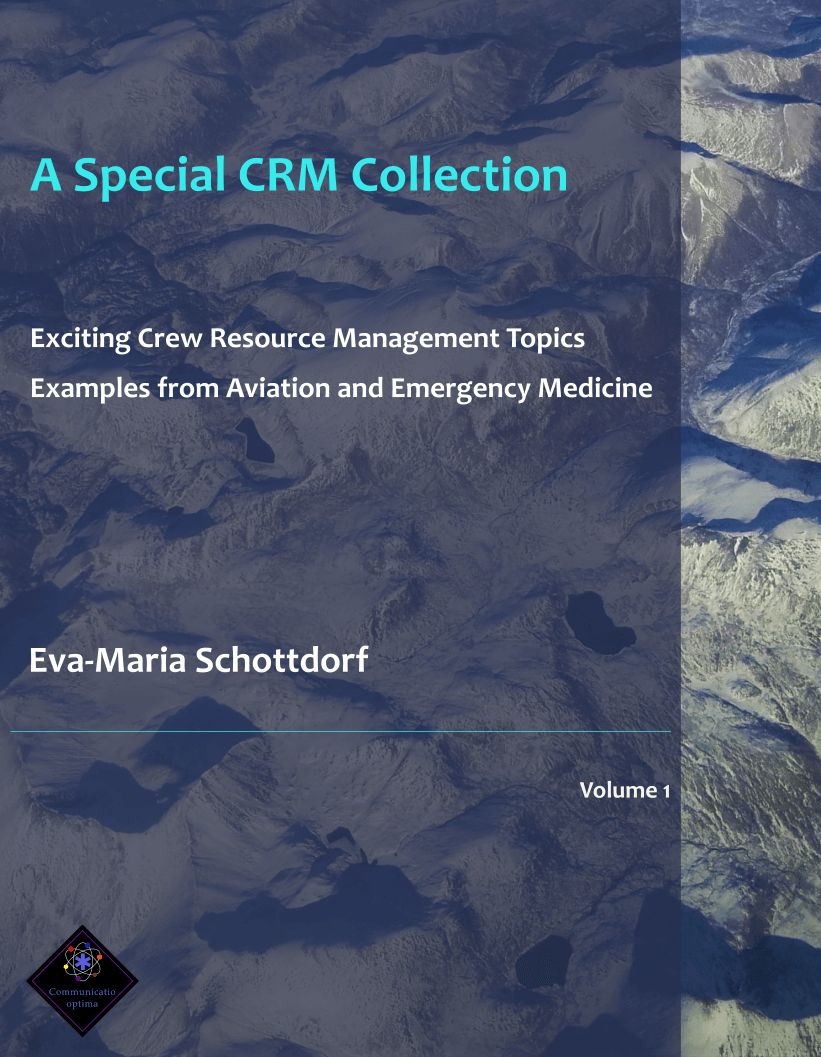
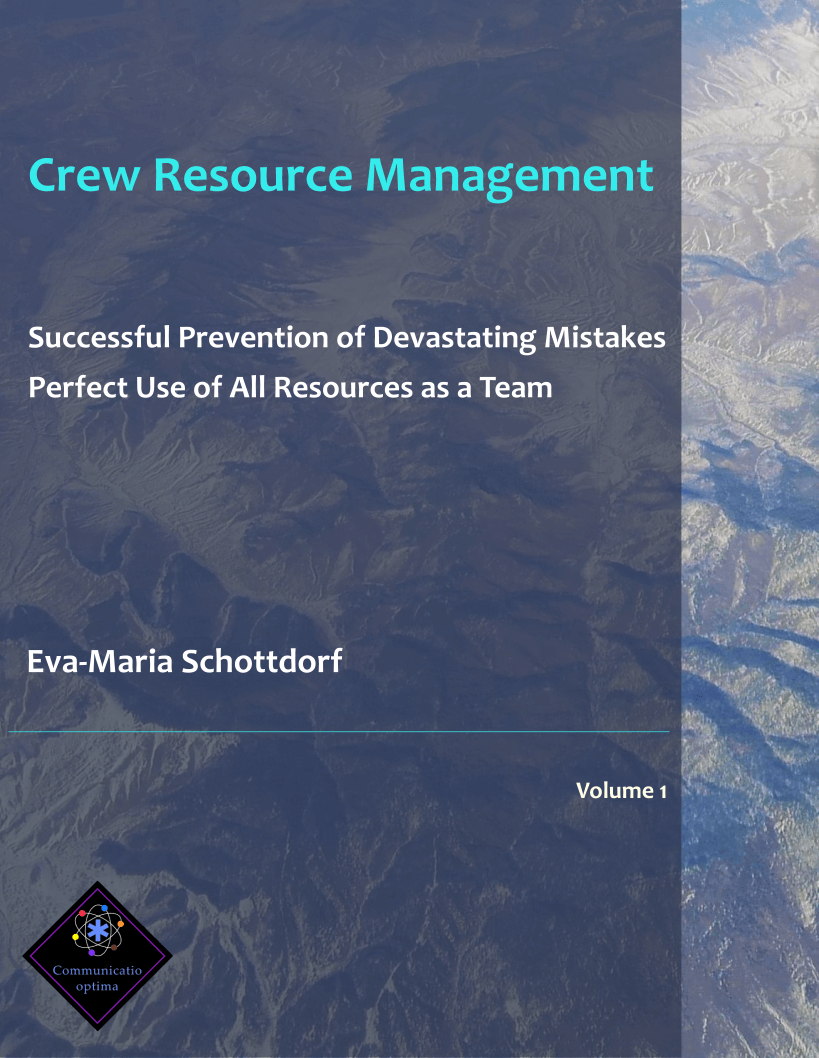
Read more about me, my career path, and my enthusiasm for CRM in my Profile .
